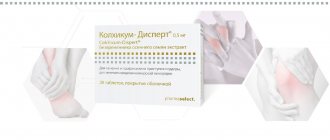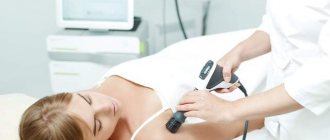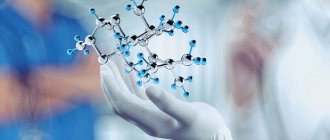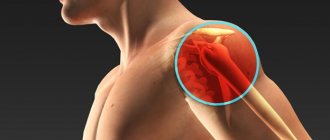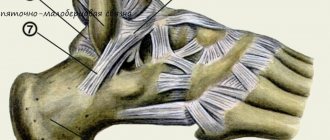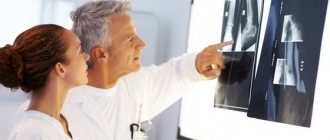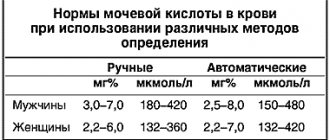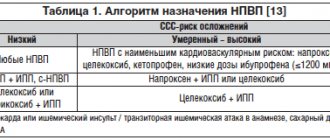ASPIRIN® - life without pain
| One of the most famous drugs in the world, ASPIRIN®, appeared in 1897 in the laboratory of the German chemist Felix Hoffmann, who worked at the Bayer company. The scientist was prompted to create it by his father’s health condition - he suffered from severe rheumatic pain and could not move, and the means existing at that time did not help or caused too pronounced adverse reactions. It was the search for an effective and safe (see “PHARMACY Weekly” No. 42 (613) dated October 29, 2007 and No. 41 (612) dated October 22, 2007) anesthetic that led F. Hoffman to the synthesis of the drug ASPIRIN®. From that moment, its triumphal march across the planet began, and today ASPIRIN® remains one of the most famous and popular analgesics in the world. |
Pain is a very important defense mechanism. In order to protect the body from a damaging factor, its motor component manifests itself - the avoidance reflex: withdrawing the hand, searching for a forced position, reducing motor activity. There are people with a congenital inability to feel pain, and as a result of the lack of its protective function, they suffer from serious injuries and fractures, as well as various diseases, because they do not feel pain symptoms and do not seek medical help in a timely manner.
Pain is a serious sign of trouble in the body, but as soon as the signaling function of pain is exhausted, it becomes evil. With prolonged exposure, painful sensations create constant discomfort, are accompanied by a deterioration in mood, the appearance of feelings of fear, anxiety, and lead to a decrease in immunity and psychosomatic disorders.
Nonsteroidal anti-inflammatory drugs (NSAIDs, non-narcotic analgesics, antipyretics) are drugs of various chemical structures that have anti-inflammatory, analgesic and antipyretic effects and do not have narcotic potential. The analgesic effect of non-narcotic analgesics, including acetylsalicylic acid (ASA), develops, as a rule, 0.5–2 hours after their administration and manifests itself mainly in moderate pain syndrome, especially in somatic pain (occurs when a damaging stimulus affects the free nerve endings in the skin, subcutaneous layer, muscles and joints), to a lesser extent with visceral (develops with irritation of pain receptors located in internal organs) and neuropathic (with irritation of peripheral nerves, afferent pathways of pain sensitivity in the spinal cord and brain). Drugs of this group are practically ineffective for pain caused by severe trauma, abdominal surgical interventions, etc.
The analgesic effect of NSAIDs is primarily a consequence of their anti-inflammatory effect, that is, it is associated, on the one hand, with a decrease in the formation of inflammatory mediators, which also exhibit the properties of algogenic substances (kinins, prostaglandins, cytokines, neuropeptides, etc.), and on the other hand, with a decrease in tissue edema in the focus of inflammation and weakening of mechanical compression of nociceptors in it. The key point in the anti-inflammatory effect of NSAIDs is their inhibition of the enzyme cyclooxygenase (COX). ASA irreversibly inhibits COX-1 and COX-2.
It is known that the analgesic effect of NSAIDs develops after 10–30 minutes, and the anti-inflammatory effect after 2–12 hours. This indicates a central component of the analgesic effect, which is not associated with the elimination of the inflammatory reaction. A number of studies have proven that ASA has the property of inhibiting the transmission of peripheral pain impulses to the central nervous system (Chen ACN, Chapman CR, 1979; Yaksh T. et al., 1992).
A doctor of any specialty is faced with the problem of pain and the fight against it. This problem is also often encountered by pharmacists and pharmacists, to whom patients turn to with questions of pain relief. They especially often ask for an over-the-counter analgesic to relieve acute or chronic pain of low or moderate intensity that has not led them to see a doctor. Relieving more severe forms without prior consultation with a doctor carries a serious danger for the patient, since it can mask life-threatening pathological conditions. In this publication, we will look at pain relief using the now classic, effective and safe drug ASPIRIN®, which has been successfully used for more than 100 years.
When contacting a pharmacy or a doctor with a question about pain relief, patients present complaints indicating the part of the body where the pain is localized - headache, dental, joint, muscle and nerve pain.
Headache
Headache is one of the most common symptoms encountered by doctors. There are at least 45 known diseases in which headache can be the only or leading manifestation. It can be of a different nature and localized in different areas of the head, depending on the reasons that caused it. Headache can be a sign of such threatening pathological conditions as hypertension, brain tumor, intracranial hypertension, meningitis, encephalitis, etc., and this is precisely what poses the danger of self-medication. However, there are several classic causes of headaches for which the use of ASPIRIN® is very effective.
Migraine is a recurrent headache of a pulsating nature, the development of which is associated with spasm and dilation of the arteries of the brain. Usually the pain is one-sided, but the side may change from attack to attack. In children, headaches are often bilateral and localized in the frontal region. In most cases, migraine first occurs between the ages of 10 and 30. The onset of an attack can be heralded by an aura - a kind of stereotypical sensation that occurs immediately before a painful attack: flashing before the eyes, flashes of light, distortion of the perception of the surrounding world, numbness of the limbs, discomfort in the stomach, etc. However, an attack can also begin suddenly. Migraine very seriously reduces the quality of life of patients and their ability to work, forcing them to constantly live in fear of a new attack.
Migraine is considered a disease of women, especially often it occurs in women 18–45 years old. However, men also often suffer from this disease. As a rule, these are successful people, responsible and educated, but at the same time emotionally vulnerable. Migraine is jokingly called the disease of great people - Julius Caesar, Frederic Chopin, Friedrich Nietzsche, Charles Darwin, Sigmund Freud, Thomas Jefferson, Edgar Allan Poe and many other celebrities suffered from this disease.
Currently, a large number of medications are used to relieve a migraine attack, among which a significant place is given to 5HT-serotonin receptor agonists - triptans. These drugs relieve migraine pain well, but have 2 main disadvantages: high cost and limited use in patients with cardiovascular diseases. Therefore, there is a constant search for alternative medicines for the treatment of migraine. One of these drugs is the classic analgesic ASPIRIN®. Thus, in 2007, the winner of the award for outstanding achievements in the study of this drug was Professor Hans-Christoph Diener, an expert in the field of headaches and director of the neurological clinic at the University of Essen in Germany. And he received this award (at the XIII International Congress on Headache in Stockholm) precisely for research into the use of the drug ASPIRIN® for migraine, the results of which proved its effectiveness.
The mechanism of the analgesic effect of the drug ASPIRIN® for migraine has not been fully studied. It is believed that it has a combined effect (peripheral - blockade of COX and central - inhibition of the transmission of pain impulses in the spinal cord). Currently, the theory of blocking the endothelium-relaxing factor (nitric monoxide - NO), which causes vasoconstriction (an effect opposite to the use of nitrates for coronary heart disease), is also being considered. Thus, ASPIRIN® - an effective, safe and inexpensive remedy for migraine - can serve as a drug with which one should begin to stop an attack, and one should switch to triptans in cases where a pronounced analgesic effect could not be achieved.
A large number of people also suffer from psychogenic headaches. This condition includes headaches of mental and physical tension, anxiety and depression. It is most often caused by increased stress, chronic stress, fatigue, acute emotional experiences, excessive alcohol consumption, smoking - factors that have already become common in the life of a modern person. The mechanism for the development of such pain is associated with tension in the cervical, chewing, temporal muscles, and facial muscles, which may be associated with emotional stress - an involuntary reaction of the facial muscles and scalp muscles occurs in response to strong emotions, even positive ones! Pain syndrome often occurs as a consequence of an incorrect forced position of the body during sedentary work, uncomfortable posture during sleep; It can also be caused by prolonged squinting, clenching teeth, or chewing gum. Patients complain of aching or pressing headache, usually diffuse or localized in the occipital, temporal or frontal region and almost always bilateral.
Treatment of psychogenic headache has certain problems. As the name and mechanism of occurrence suggest, for successful therapy it is necessary to eliminate the patient’s incorrect psychological stereotypes of behavior. However, what complicates the situation is that many people suffering from this type of headache have clinical signs of depression, and without adequate antidepressant treatment it is almost impossible to help them.
In any case, you should not endure a headache, because it aggravates unpleasant psychological experiences and can lead to an intensification or consolidation of its stereotypical appearance in response to any psychological stress. And here ASPIRIN® will come in very handy - it can effectively eliminate pain. To enhance the effect, it is recommended to perform an independent massage of the temporal region, neck muscles, and rubbing the scalp with your fingertips. And it will be possible to find out psychological problems after the pain passes.
Headache can also appear with colds, and the use of the drug ASPIRIN® to relieve this symptom has long been a classic method of treatment, especially since it has an antipyretic and anti-inflammatory effect.
Toothache
Toothache is a clear signal that you need to see a dentist. Of course, if this cannot be done immediately, it must be eliminated, but constant use of an analgesic without adequate dental care can lead to tooth loss or the development of serious complications. ASPIRIN® can reduce the severity or eliminate toothache, so it can be recommended as an analgesic in this case, especially since it is often on hand or in a home medicine cabinet. Both in the presence of a temporary effect and in its absence, it would be advisable to immediately consult a dentist.
Pain in joints and muscles
Acute, chronic or frequently recurring pain in joints, bones and muscles is not uncommon in adults, and is especially common in older people. In the pathogenesis of such pain, mechanical factors play an important role (overload of a joint, especially a diseased or damaged one, stretching of the tendon-ligament apparatus), inflammation of the synovial membrane, microcirculatory disorders; metabolic disorders in bones; development of inflammatory and degenerative changes in joints. As a result of these processes, algesics (tissue proteases, kinins, prostaglandins, histamine, serotonin) accumulate in the joint tissues, which irritate pain receptors (nociceptors) located throughout the body, with the exception of the brain, and give rise to the sensation of pain. There are no pain receptors in the synovial membrane, cartilage and menisci, but pain in the joints in people of different ages is most often associated with changes in the periarticular tissues, richly supplied with nociceptors.
The clinical manifestations of rheumatic diseases are different, but there are characteristic ones - the so-called articular syndrome: severe long-term pain, local inflammation, manifested by swelling, increased skin temperature over the affected joints, deformation and deformation of the joint (changes in its shape due to swelling of the periarticular tissues and pathological tissue growths), restriction of movement in the joint and, as a result, disruption of its function. Inflammation is the most universal pathological process underlying the clinical manifestations of rheumatic diseases.
All NSAIDs, including ASPIRIN®, are very effective in eliminating pain and inflammation in this pathology, however, once again it should be emphasized the danger of self-medication and the need to consult a doctor for prolonged and intense pain in the joints, and even more so if this is accompanied by deformation or severe swelling. However, in case of injury or sprain, ASPIRIN® will effectively relieve inflammation and pain.
The most common causes of muscle pain are the following: influenza and other acute respiratory viral infections, sciatica, bruise or muscle strain - ASPIRIN® will quickly and effectively eliminate pain in all these conditions.
Pathological pain
Separately, it is necessary to dwell on pathological pain - a condition when pain becomes an independent form of the disease. For a better understanding of the issue, we will briefly highlight modern views on the pathogenesis of pain.
The perception of pain as a reflex act is outdated. The basis of modern views is the neuromatrix theory - a new conceptual model of the nervous system (Melzack R., 1999). According to this theory, all qualitative characteristics of pain are generated in the brain, and peripheral stimuli represent only nonspecific “triggers.” This means that signals about damage are transmitted to the central nervous system, where, based on past experiences of pain, social stereotypes, and the functional state of the body, a pain sensation is formed, which is perceived by a person.
With prolonged painful stimulation, normal sensory neurons become hyperexcitable and areas of abnormal activity appear in them. This activity leads to the formation of algogenic substances in the nerve endings: serotonin, prostacyclins, leukotrienes, cytokines, bradykinins. All these biologically active substances significantly enhance and maintain peripheral pain stimulation. This pathological process is called neurogenic inflammation. Painful sensations can occur even with minor tissue irritation in all visceral organs, which is typical for patients with chronic degenerative diseases of the musculoskeletal system, irritable bowel syndrome, etc.
An increased flow of impulses in the central nervous system leads to central sensitization, which transfers the pathological process to a new level of development, the appearance of virtual pain without the presence of an irritant, which is very painful for patients and sharply worsens their quality of life.
ASPIRIN® acts on the first two levels of chronic pain —
weakens peripheral nociception and associated peripheral sensitization of the nervous system. Therefore, the drug is indicated for the treatment of pathological pain, and also reduces the likelihood of such a condition occurring due to untimely and inadequate relief of chronic pain syndrome.
We touched upon only some common cases of use of the over-the-counter analgesic ASPIRIN® and made sure that this well-known drug is effective and safe in relieving pain of various origins. Both pain relief without adequate medical care and the lack of necessary pain relief can cause damage to the patient’s health. As a golden mean, the drug ASPIRIN® can be chosen.
Let's summarize:
– ASPIRIN® is effective for pain of low or moderate intensity, especially of inflammatory origin;
– the use of ASA, as well as any other analgesic, eliminates only the symptoms, but not the cause of the disease, therefore the appearance of pain is a signal of the need to see a doctor as soon as possible;
– ASPIRIN® is not recommended for use in diseases of the digestive tract, gout, hemophilia or other blood clotting disorders, when taking anticoagulants, or hypersensitivity to ASA.
Concluding another section of the medical “biography” of the drug ASPIRIN®, it should be emphasized that despite its more than century-long history in medicine, taking into account the deepening and expansion of our knowledge about the mechanisms of its action, as well as the pathogenesis of the occurrence and development of pain as a possible independent nosological units, the use of the drug ASPIRIN® and other ASA derivatives as an analgesic is still relevant today, which objectively implies a good scientific and practical perspective. o
A.P. Viktorov, Doctor of Medical Sciences, Professor, Head of the Department of Clinical Pharmacology with the Laboratory of Functional Diagnostics of the National Scientific Academy of Medical Sciences of Ukraine
New data on the role of acetylsalicylic acid in the treatment of COVID-19
On June 15, during “Scientific Tuesday,” the head of the department of fundamental and clinical problems of thrombosis in non-infectious diseases of the Federal State Budgetary Institution “National Medical Research Center for Traumatology and Medicine” of the Ministry of Health of Russia, Doctor of Medical Sciences. Igor Semenovich Yavelov presented data from randomized clinical trials on the use of acetylsalicylic acid in the drug therapy of COVID -19.
It has been proven that thrombus formation processes play a significant role in the progression of the new coronavirus infection. Currently, subcutaneous or intravenous administration of heparin drugs is widely used in the hospital for the treatment of COVID-19. However, evidence is accumulating that drugs that reduce the functional activity of platelets (antiplatelet agents) may also be useful, among which acetylsalicylic acid is most often used.
Thus, according to a pooled analysis of 6 retrospective studies, which included a total of 13,993 patients with COVID-19, the use of a low dose of acetylsalicylic acid prehospital or in the hospital indicated a twofold reduction in the risk of death when compared with those who did not receive this antiplatelet agent, regardless of the presence of other factors, associated with an unfavorable outcome of the disease. The results of the analysis of cases of initiation of acetylsalicylic acid use in a hospital were similar. At the same time, on the one hand, such a pronounced positive effect looks implausible, on the other hand, it is known that evidence of this kind can be misleading, since the decision to prescribe or not prescribe a drug to a particular patient depends on the decision of the doctor, whose motives are not always known , and there is never any certainty that the comparison groups were similar (comparable) in all features that could influence the outcome of treatment. Only randomized clinical trials can give a definite answer to the appropriateness of a particular approach to treating patients.
The results of the first of them were disappointing: in the multicenter open clinical trial RECOVERY, the administration of acetylsalicylic acid at a dose of 150 mg 1 time per day before discharge in patients hospitalized with COVID-19 had no effect on mortality over 28 days of observation compared with standard treatment of the disease. without the use of acetylsalicylic acid. However, there was no benefit when starting treatment within the first 7 days and later from the onset of symptoms, in the absence of the need for respiratory support/oxygen breathing and various forms of respiratory support, with or without the use of corticosteroids. There were no differences between groups in the frequency of patients requiring non-invasive and invasive pulmonary ventilation or renal replacement therapy. In general, the study began in the first days after hospitalization, and initially the severity of the disease was not critical (mechanical artificial ventilation was performed in only 5% of patients).
As a result, there is no reason yet to use acetylsalicylic acid in all patients hospitalized with COVID-19. Its study in this disease (including outpatient treatment) continues in a number of randomized clinical trials. Accordingly, it is possible that after new facts emerge, ideas about the role of acetylsalicylic acid in COVID-19 will be clarified or revised.
